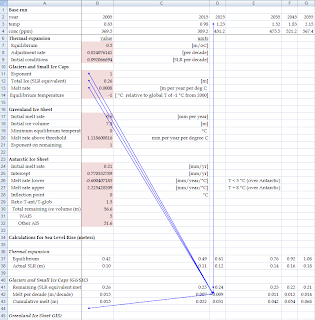The older DICE (Dynamic Integrated Model of Climate and the Economy) models were available in GAMS and Excel (http://nordhaus.econ.yale.edu/DICE2007.htm). The latest RICE model is only available in Excel (http://nordhaus.econ.yale.edu/RICEmodels.htm). For a project I was studying how the Sea-Level Rise (SLR) functionality was incorporated in the model. I noticed a few places where the Excel formula’s have somewhat surprising forms. They may be bugs or it may be harmless.
The first case is where a series of formula’s calculating the Cumulative Melt for Glaciers and Small Ice Caps. This is row 42 in sheet SLR of http://nordhaus.econ.yale.edu/documents/RICE_042510.xlsm. The formula’s use cell B44 which is empty.
The second case is where a series of formula’s for different years suddenly use a different constant. This is in row 55 in the same sheet SLR (melt rate for Antarctic Ice Sheet). For up to 2115 the formula refers to B25 (Intercept), and after that it uses B24 (Initial Melt Rate).
I am not sure these are bugs, but this certainly looks as a mistake.
Of course I would prefer the models to be available in GAMS. That would probably have prevented errors like this. Without doubt, maintaining two different versions is difficult, and they can easily get out-of-sync. In a different paper (http://www.seas.harvard.edu/climate/pdf/Fuessel.pdf) it is argued that the GAMS and Excel versions of DICE contain different formulations, illustrating my point.
Of course we must applaud Nordhaus for making this work publicly available. That invites criticism. However if people (like me) take the effort to study and comment on the models, that is also a sign that these models actually do matter.
I have notified the author of these (possible) bugs.
Update: The first issue is a bug, but with limited effect in the long run. The second issue is actually as intended: a change in calibration to make things more in line with other results.


No comments:
Post a Comment